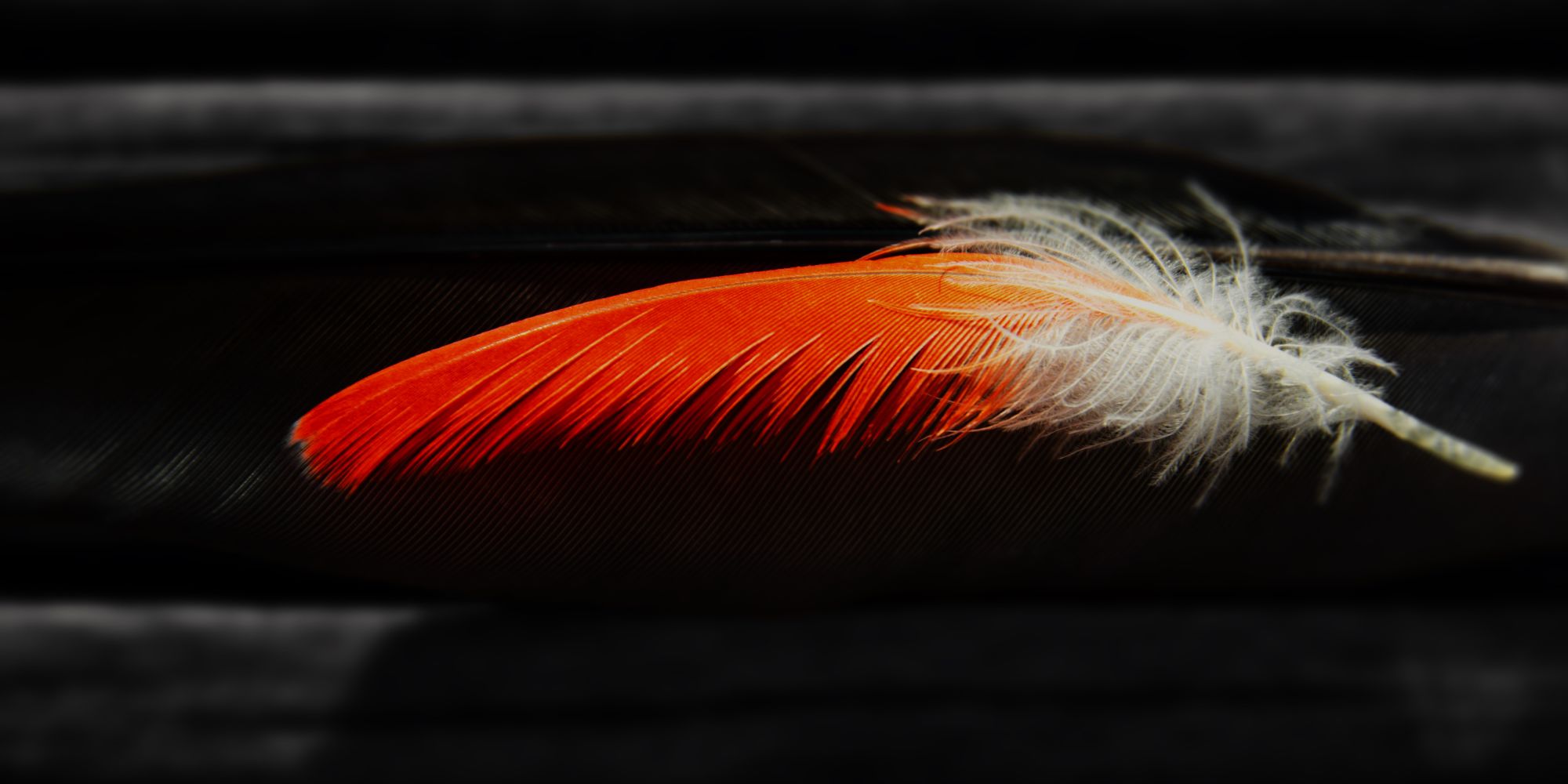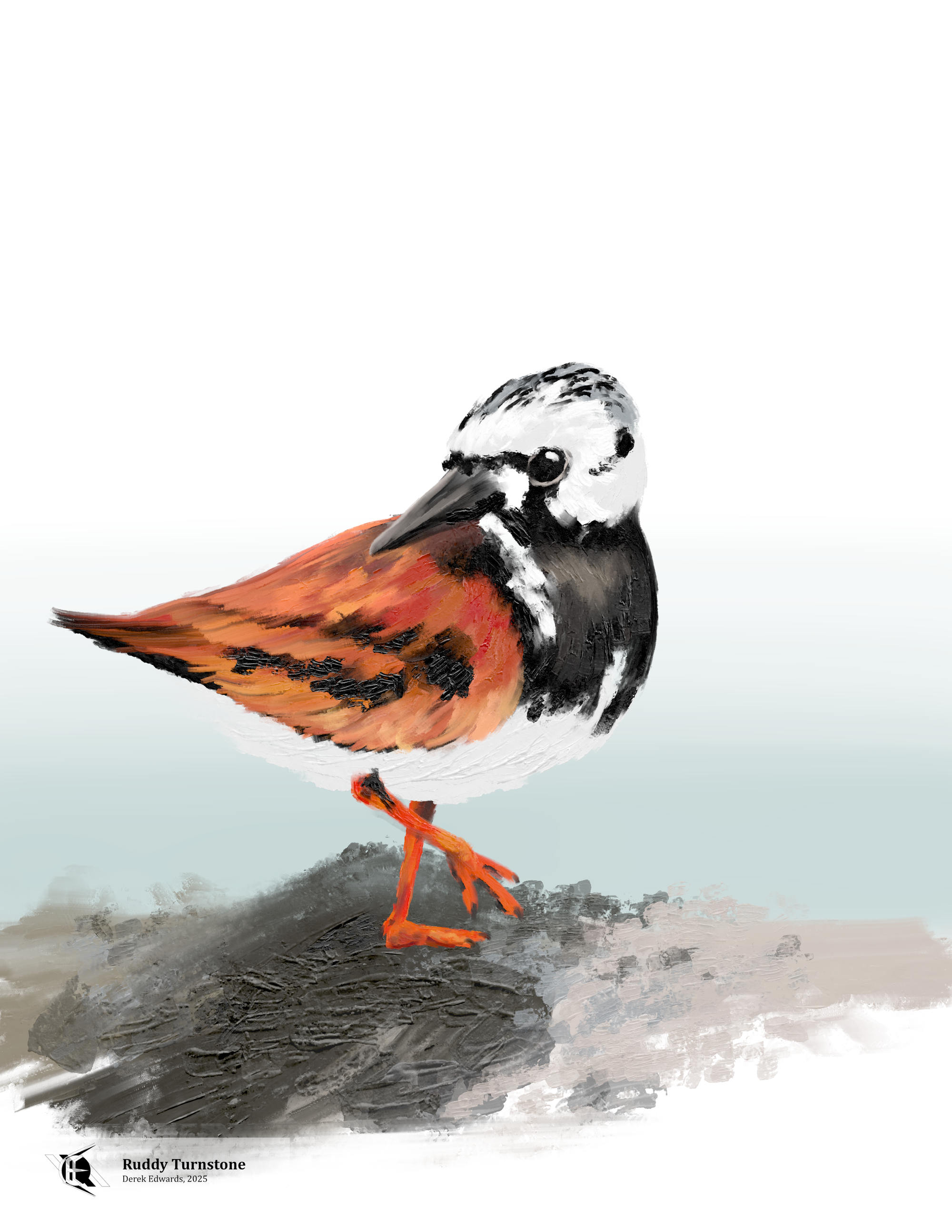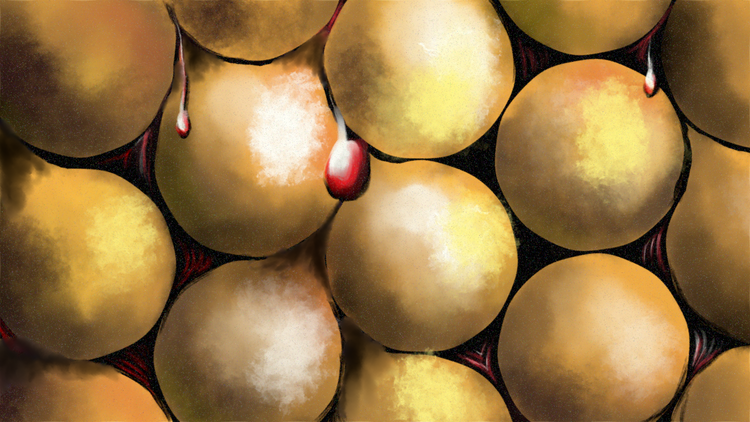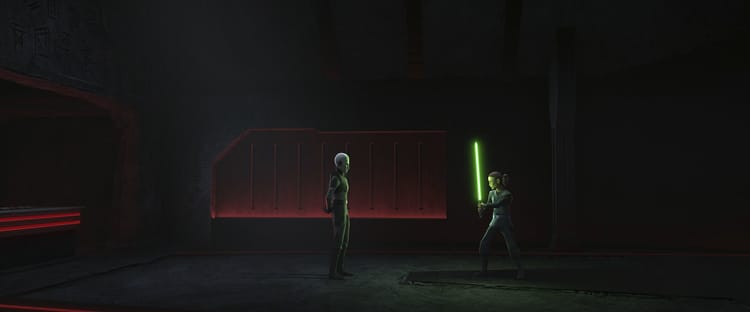
Running Commentary 4/21/2025
Hello,
Spring has truly arrived, at least according to the sparrows. I’ve seen a chipping sparrow and a white-throated sparrow both in my yard in the past week. A tree sparrow and a few juncos are still hanging around, but I expect they’ll be clearing out soon as we warm up.
Also, you'll notice that this Bird of the Week I tried something a little different in my drawing technique; I used some impasto brushes for Krita. They worked pretty well until it came time to do the details, and then it fell apart. I think the picture came out okay for this bird but I don't think I'll do this again
Anyway...
Watching...
Star Wars Celebration
I didn’t actually watch any of this, but I did monitor the announcements, which mainly dealt with things that I will be watching when they’re out:
- The Mandalorian and Grogu - This film will be coming next May. While I think that Din Djarrin and Grogu have had their story wrapped up nicely — twice — I also expect this to be a decent film and a safe bet to return Star Wars to theaters. I’m interested to see what the Mandalorian team can do with a full feature-film budget.
- Star Wars: Starfighter — This film will be coming in May of 2027. We don’t know anything about it other than its title, director, and star, but so far I’m pretty hopeful. Starfighter stuff is a big part of Star Wars, something that really invites the cinematic treatment. Shawn Levy is mainly a comedy director, so I’m not expecting anything terribly gritty. I’ve not personally seen much of Ryan Gosling’s work, but I will say that he seems protective of his reputation as an actor; he’s not looking to catch his big break nor is he the sort who will appear in just whatever.
- Maul: Shadow Lord — This will be an animated series filling in the story of Maul between his escape from Mandalore at the end of the Clone Wars and his cameo appearance at the end of Solo. Sam Witwer will return to voice Maul. I’m really looking forward to this. The series will release on Disney+ next year.
- Visions — Volume 3 of this non-canonical anthology series will come to Disney+ in October. It will be all-Japanese anime studios once again, with three of the shorts being sequels to some from Volume 1; additionally, “The Ninth Jedi”, which out of all of Volume 1’s offerings was the one I most wanted to see more of, will be getting not only a follow-up short in Volume 3 but an entire long-form spin-off; it is undisclosed when this spin-off will be coming from what I can tell. I really like Visions, and I’m glad to see Lucasfilm continuing and expanding it.
- Ahsoka — Season 2 is coming soon, and we got a few details about who will be in it. We’ll be getting Zeb, who, oddly, never appeared in the first season despite every other surviving member of the Rebels cast doing so, so that’s nice. Also, Hayden Christensen will return as Anakin Skywalker again, in some capacity; I kind of hope his spirit doesn’t appear to Ahsoka — I think they wrapped things up between the two of them very conclusively last season — but we could get either some more flashbacks or maybe (I’m not counting on this but it would be cool) Anakin’s spirit appears to Baylan.
- No mention was made of the movie about Rey’s New Jedi Order, which…does not bode well for that project, which was originally slated for this year before getting delayed. I’m hoping that Lucasfilm is just taking a step back to make sure they get it right, since I really do think there’s a great story to be told about Rey following The Rise of Skywalker.
Next week I’ll have my notes on the first three episodes of Andor season 2.
Eating...

Flatfish with Black Pepper Butter
Yesterday was Easter Sunday, one of the rare ecumenical Easters that fall on the same day for both the Western and Eastern churches, which means that Lent is over with worldwide and the last thing a lot of people want to have for dinner is fish. So my apologies for both providing you with a recipe for fish and for having you use part of a lemon, but this is the best new dish I’ve made this year. It can be made quite quickly and is just delicious, exactly the kind of thing you want from a fish dinner. I suggest serving it with some vegetables and/or some good bread, as flatfish isn’t especially filling and the butter sauce is quite rich.
Ingredients:
- 6 fillets flatfish (flounder, pollack, tilapia; any mild fish with thin fillets)
- 1/3 cup flour
- 2 TBSP oil
- kosher salt
- 8 TBSP butter
- 2 tsp black peppercorns
- 1 tsp ground black pepper
- 2 TBSP lemon zest
- 2 TBSP lemon juice
Procedure
- Crush the peppercorns, cracking them open but not grinding them to powder.
- One-by-one, sprinkle fish fillets with salt on both sides and dredge lightly in flour.
- One-by-one, cook fillets in a non-stick pan with oil, over medium-high heat, for two minutes on one side and then for 30 seconds on the other; remove fish to a platter afterwards.
- Melt butter in a saucepan on medium heat.
- Add crushed peppercorns to butter.
- Cook the butter until it foams and browns, then immediately remove from heat.
- Add lemon zest and lemon juice to butter.
- Pour butter over fish and serve.

Bird of the Week
I’ve mentioned before that I like the books of Jennifer Ackerman, who has written, thus far, four books about birds. One of these, The Genius of Birds, tells about the surprising intelligence of many bird species. She writes of talking parrots, tool-using crows, seed-stashing chickadees, and navigating pigeons. She praises the house sparrow for its innovative mindset as it’s encountered new habitats as it’s tagged along behind humanity as we’ve spread throughout the world. And as she does that, she mentions another bird as a contrast, the Ruddy Turnstone:1
Compare all this with the ruddy turnstone, a small wading bird near the bottom of the innovative-behavior totem pole. In his book The Wind Birds, Peter Matthiessen describes an early experiment on the shorebird’s behavior by eighteenth-century English naturalist Mark Catesby: “Catesby provided a ruddy turnstone with stones to turn, the better to observe the feeding trait that gives the bird its name. In a time when scientific experiments were less complex than they are today, the bird was furnished systematically with stones that had nothing beneath them, whereupon ‘not finding under them the usual food, it died.’”
The turnstone is the only bird that Ackerman specifically calls out as stupid in the whole book, and I must say that it sort of has colored my impression of the species, which I know little about otherwise. But is this fair? Are turnstones truly so locked into their single way of feeding that they’ll starve if their food isn’t under stones?
Ackerman mentions the experiment was performed and recorded by Mark Catesby, so let’s start by looking into that; Catesby, in his Natural History of Carolina, Florida, and the Bahamas records that when he was aboard a boat off the coast of Florida in 1702:2

the Bird from which this [drawing] was figur’d flew on Board us and was taken. It was very active in turing up Stones, which we put into its Cage; but not finding under them the usual Food, it died. In this Action it moved only the upper Mandible; yet would with great Dexterity and Quickness turn over Stones of above three Pounds Weight. This Property Nature seems to have given it for finding its Food; which is probably Worms and Insects on the Sea-Shore.
Having read this original account from Catesby, I’m curious: did he give it anything to eat? The bird was caged aboard a ship. It sounds less like it starved because it didn’t find food under the rocks and more like it starved because it didn’t find suitable food anywhere. Catesby was correct about what the turnstone ate, for the most part, but his speculative tone makes me think he didn’t actually try to feed his bird any worms or insects, presuming he tried to feed it at all.
In the intervening three centuries, we have learned about what ruddy turnstones eat. They do, indeed, eat marine invertebrates that they find hiding in rocks or mud, but they aren’t incapable of recognizing more exotic fare, as can be attested by the fact that they will eat the eggs from unattended gull nests.^3^ And actually, turnstones seem to put a lot of thought into eating. The researcher D. Phillip Whitfield watched flocks of turnstones feeding in coastal Scotland, where some populations of turnstone winter; he noted that turnstones, in addition to their eponymous stone-turning method, will employ five other methods to feed, including a means of digging though seaweed that he called “routing”. Whether turnstones routed for food or turned stones seemed to depend on their social status. Big-shot turnstones tended to rout, while the more dweeby turnstones tended to turn stones; when Whitfield captured some of the routing turnstones and removed them from a flock, the remaining turnstones started to route for food more than they had before.^4^ It would seem that seaweed marks the best food, the prize accorded to the flock’s top turnstones, and that when the birds feed, they have to make social judgements to determine where and how they’ll eat. At risk of anthropomorphizing these birds, this reminds me of the complete table manners employed at royal banquets. It does not seem like dumb instinct.
- Ackerman, Jennifer. The Genius of Birds. Penguin Books, 2016. p.246
- Catesby, Mark. The Natural History of Carolina, Florida, and the Bahama Islands. Vol. 1, Part 4. London, Benjamin White, 1771. p. 72 https://dcr.lib.unc.edu/record/40b2ddfa-e755-40ca-8442-e1789e84d53a.
- Parkes, Kenneth C. and Lapham, Helen (1971) "The Ruddy Turnstone as an Egg Predator," Wilson Bulletin: Vol. 83 : Iss. 3 , Article 16. Available at: https://digitalcommons.usf.edu/wilson_bulletin/vol83/iss3/16
- Whitfield, D. Philip. “Individual Feeding Specializations of Wintering Turnstone Arenaria Interpres.” Journal of Animal Ecology 59, no. 1 (1990): 193–211. https://doi.org/10.2307/5168https://www.jstor.org/stable/5168.
- Jobling, J. A. (editor). The Key to Scientific Names in Birds of the World (S. M. Billerman et al. editors), Cornell Laboratory of Ornithology, Ithaca.
Curation Links
Google Spoofed Via DKIM Replay Attack | Gerasim Hovhannisyan, EasyDMARC Blog
News you can use, perhaps, about a scam pretending to be Google turning your Drive files over to the police. This article is written for industry insiders who know what “DKIM” means, but the gist of it is a) the email was made to look like it genuinely came from a Google email address and b) the scam link sends to a “sites.google.com” domain, which, while hosted by Google, was not set up by Google. The big thing to remember is that “sites.google.com” is the domain for user-generated sites, not for Google’s own stuff.
Mortal Coils | Cutter Wood, Harper's Magazine
Excerpted from Wood’s Earthly Materials: an essay about the hair that the dead leave behind, especially the hair, taken for use in wigs and now held, undisplayed, by museums, of those killed in the Holocaust. Is this too personal a personal effect to be displayed, or too personal to be kept hidden?
The book ladder: The history of a totally necessary invention | Chason Gordon, Slate
“The book ladder is the pinnacle of achievement for any aspiring book lover. Gliding along a railing system parallel to the bookcase, it is the finishing touch that completes any library, whether public or personal. Its presence makes tangible an embrace of learning, represented by a wall of needlessly high books anchored by the most specialized of ladders. It signals to guests that you’ve ostensibly read so many books and acquired so much alleged knowledge that you need extra assistance to get to it.”
Lunar | Tyson Johnston, DUST
[FICTION] [VIDEO] “A life sentence regardless of the crime. A destitute Earth stricken with hunger and crime. A planet where the smallest of infractions can result in the gravest of consequences. Tyson Johnston’s LUNAR makes the last frontier a one-way ticket to a hellish nightmare for Earth’s convicts they can no longer support. Taken from their homes to the Lunar penitentiary, these men with a penchant for breaking the law find themselves on a moon that thrives of the absence of justice. The new wild west, where there is no law and their fate is determined at the hands of a government where there’s no one to account for their actions. But one man may have found a way for their voices to be heard. A way to escape and tell the people of his home planet of the atrocities they’ve been subject to. A way to seek justice for the harrowing sentence he’s been dealt and if justice can’t be found, revenge.” (6 minutes)
See the full archive of curations on Notion






Member Commentary